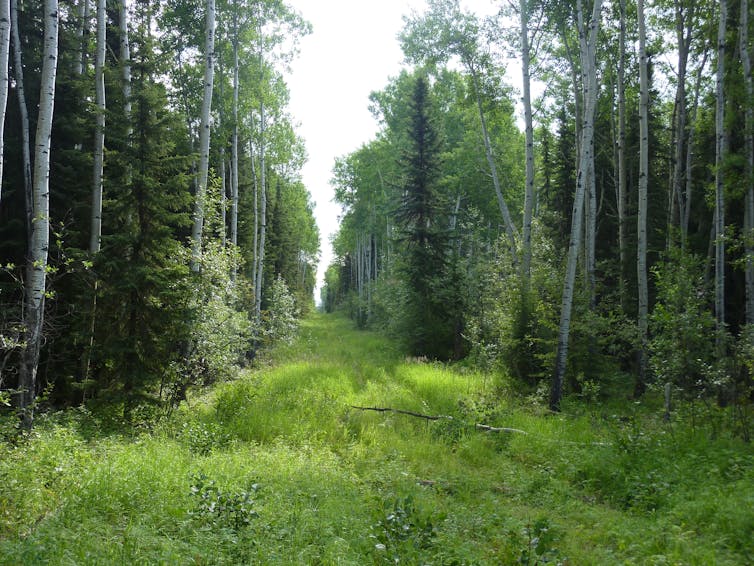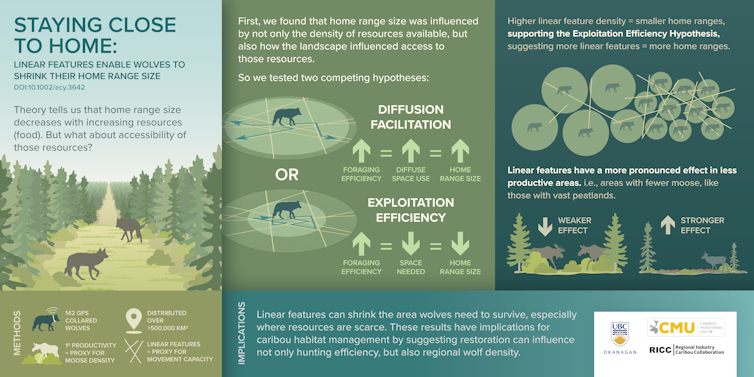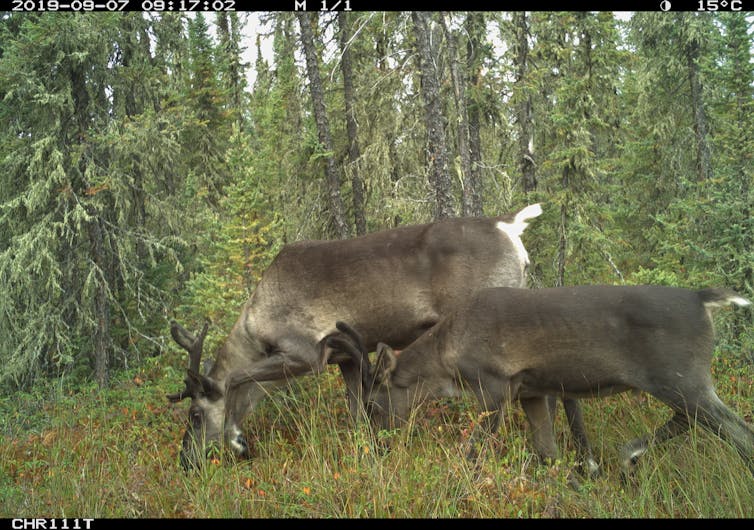The swamps of the Minesing Wetlands, a 15,000-acre area about 15 kilometres west of Barrie, Ont., are not the most immediately welcoming of places. Convincing someone to spend a day exploring the thick, forested marshes—with clouds of mosquitoes in the air and bloodsucking leeches in the water—isn’t easy. I should know. I’ve been trying to convince friends to join me on a trip there for years. Again and again, my attempts are met with two questions: why would I visit, and why should I care?
Answering the first question is easy. Despite seeming unappealing, the Minesing Wetlands (sometimes called the “Everglades of the North”), are one of our country’s most significant wetland systems. As a conservation biologist helping to map out some of Canada’s most important places for nature, I’m excited to see some of the dozens of rare and endangered species that still call the Minesing Wetlands home. One species here has piqued my interest above all others—a jewel in this swampy rough. It’s called Hine’s emerald, a large dragonfly with a metallic green body and brilliant emerald eyes.
It’s an incredibly rare species; it requires a very specific type of wetland environment, and—unlike most dragonflies, which go from egg to adult in less than a year—the aquatic larvae of this species take three to five years to grow into adulthood, relying on crawfish burrows for shelter during winter and through any dry spells in summer. The Minesing Wetlands are the only place in Canada where this dragonfly is found, so as a nature lover, the slimmest chance to see this beautiful and unique piece of Canadian biodiversity is more than enough reason to visit.
Answering the second question—why should I care—takes longer to answer. I get asked similar things quite often: why care about this one rare species, no matter how beautiful it is? Why should I care about these wetlands or any other seemingly random place? Ultimately, it comes down to understanding why conservation and nature are important at all. Sure, nature is a nice-to-have, but is it really a must-have?
Why does biodiversity matter?
Most people are aware that across Canada and the world, we’re losing more and more wild biodiversity every year. From looking at around 25,000 Canadian species that scientists have some basic understanding of (a fraction of the estimated 80,000 species in Canada), we know that about one in five species in Canada are imperilled to some degree.
These bits of Canadian biodiversity are significant internationally too. More than 300 species in Canada are found nowhere else in the world. From the adorable Vancouver Island marmot to Algonquin Provincial Park’s Eastern wolf, the planetary survival of these species depends entirely on our conservation decisions here in Canada. When it’s gone here, it’s gone everywhere.
But, sometimes when I talk to landowners and land-users—farmers, cottagers, hunters, and ATV-ers—who hear me say we need to protect species or habitat, they get on the defensive. They don’t want to be told how to use their land, or be limited in what they do on it because of some obscure plant or insect. They want to know what purpose these species serve, and if their function really outweighs the inconvenience, annoyance, or danger that these animals pose to us. They want to know, if it’s gone, does it really matter?
The answer is, yes. Many of the natural processes that humans rely on depend on biodiverse ecosystems. Consider pollination, where a huge variety of wild bees, flies, and other insects—including mosquitoes—play a crucial role in ensuring the growth and yields of the fruits, veggies, and nuts that our diets rely on. Or consider decomposition, where species of ants, termites, mushrooms, worms, and more work together to break down and recycle dead plant and animal matter, clearing the way for new life. Gardeners will be familiar with these decomposers and detritivores as some of the main players in creating compost, but without them in the wild, we would quickly be buried under piles of dead plant and animal material.
Species including rattlesnakes and black widow spiders and plants such as American ginseng might hold the cure to helping treat different diseases and conditions. Even those “annoying” species are fundamental pieces of biodiversity. Throughout their life cycle, mosquitoes help to move nutrients between aquatic and terrestrial systems. They also form a key link between phytoplankton and micro-organisms—favoured prey of filter-feeding aquatic mosquito larvae—and larger animals, from bats to frogs, fish to birds. Mosquitoes are a central component of the food web in wetlands. Losing these pesky critters could compromise the function of the wetland, an ecosystem that helps us by filtering water, acting as a buffer to hold water and prevent destructive flooding during storms and winter thaws, and fighting climate change by removing carbon from the atmosphere. These are ecosystem services that would be massively expensive to replace.
Having a variety of species participating in these functions matters as well. For example, pollination is more effective when done not just by a single species (such as honeybees), but instead by a diverse set of wild pollinators. And more biodiverse ecosystems may also be more resilient to change.
While many species might seem similar on the surface, we still lack so much understanding about the basic biology of most species and the complex interactions that they participate in within ecosystems. It’s rarely clear what effect losing a species might have. To paraphrase biologists Paul and Anne Ehrlich, early pioneers in the fields of conservation biology and environmental advocacy, losing species in an ecosystem is like blindly popping rivets off a plane while it’s flying. Some rivets might be redundant, and the plane can probably keep flying for a short while even with some structurally important rivets removed. But it’s silly to risk popping off any rivets when you don’t need to.
What can we do to help biodiversity?
We have a big (but not impossible) task ahead of us to make sure that we keep all of our rivets on the metaphorical plane (or threads in the tapestry of life, if you prefer a less utilitarian analogy). Preventing further loss and recovering biodiversity to what it was—think of it as restoring rivets that have been damaged on a plane—goes together with addressing the climate crisis. The good news is that nations are taking steps towards this.
Just this past December, 188 countries from across the world agreed to a new global framework for addressing biodiversity loss. While not perfect, the agreement contains some ambitious goals, including protecting 30 per cent of lands and waters by 2030, restoring and stopping the loss of areas important to biodiversity and of high ecological integrity, and addressing key drivers of biodiversity loss. Importantly, this agreement highlights the need for conservation to be led by (or at least happen in collaboration with) Indigenous peoples and local communities—something that is especially important here in Canada.
And it’s not just at the Minesing Wetland. Wherever you are—at the side of a lake, on the banks of a river, on the edge of a field, or deep in the woods—there are many things that you can do to help biodiversity around you. It can start as simple as creating a pollinator garden of native wildflowers (or encouraging the wildflowers that are already growing), setting aside parts of lawn or lands to stay “wild” (such as by leaving leaf litter or wetlands alone for the year), or building and properly maintaining nest boxes for species such as bats or bees.
Or you can participate in community science through apps such as iNaturalist or eBird. Local land trusts, conservation authorities, and nature groups can give you advice on the best actions to protect and steward lands you own and connect you to like-minded networks of people. Conservation doesn’t need to be hard, and doesn’t always need to be opposed to other ways of enjoying lands. By engaging with the conservation network and community around you, you can find new creative ways to take care of the land and appreciate nature.
Ultimately, stopping biodiversity loss requires action at both the local level and globally. As important as it is to protect and steward biodiversity near you, it’s also important to vote for leaders who will take conservation seriously and work to meet global commitments.
I’m looking forward to my trip to the Minesing Wetlands in search of the Hine’s emerald. I’ll keep asking people to risk the marshes and mosquitoes to join me, and along the way, start down the path of appreciating biodiversity in all its forms. Like the gears in a watch, every bit of biodiversity—whether it’s an emerald-eyed dragonfly, or a bloodsucking leech—plays some sort of role in the bigger picture and has intrinsic value of its very own. With hope and hard work—and an appreciation for the importance of all the pieces of our planet—I’m optimistic that creatures like Hine’s emerald and other rare species will be a little less rare by the time I get a chance to see them.
Peter Soroye is the Key Biodiversity Areas assessment and outreach coordinator with Wildlife Conservation Society Canada. As you read this, he’s likely on a hike that’s taking 200 per cent longer than necessary as he stops to photograph every bug, bird, and flower he sees along the way.

Related Story 26 native plants that will attract pollinators to your garden






